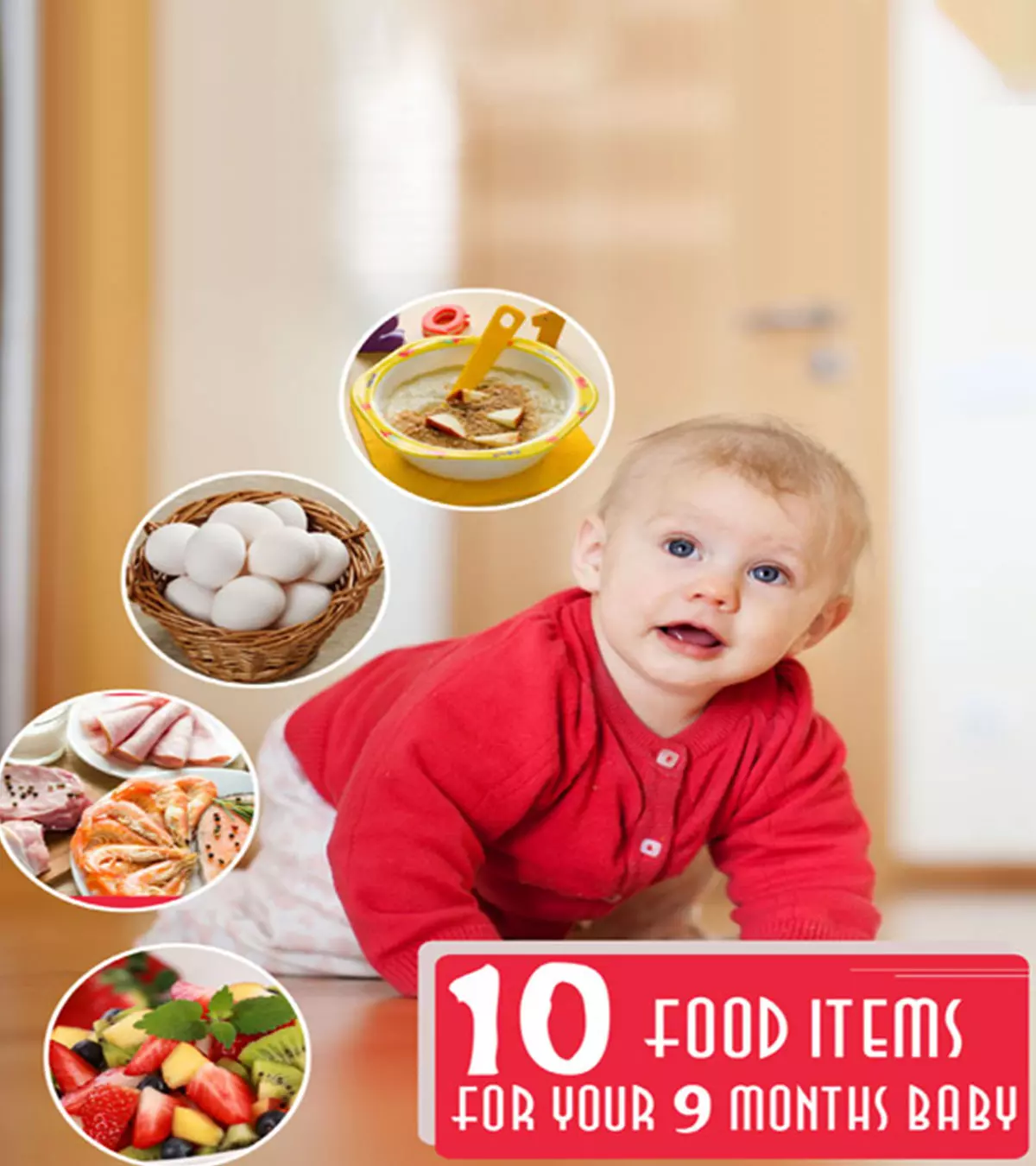
Image: ShutterStock
Parents are often worried when their babies have sleep interruptions. Several factors might be responsible for this phenomenon, the most important one being hunger (1). In such times, most parents consider adding rice cereal to the bottle.

Parents opt for rice cereal as baby food because of its numerous benefits. Many also believe that rice cereal thickens the formula and helps keep babies’ stomachs full for longer durations, facilitating a sound sleep. However, there are no research-based studies to support this belief. Moreover, this infant feeding practice has several short and long-term safety concerns.
Learn more about the safety of adding rice cereal to your baby’s bottle, the associated health problems, other alternatives, and more in this post.
Key Pointers
- Unless instructed by a physician, the American Academy of Pediatrics (AAP) advises against giving rice cereal in the bottle.
- Rice cereal in a bottle can cause choking, particularly in young infants with weak oral motor skills.
- You can introduce rice cereal to babies after six months of age.
- Adding rice cereal as thickening agents may prevent reflux but may increase the risk of excess weight gain and nutritional malabsorption.
Is It Safe To Add Rice Cereal In Baby’s Bottle?

The American Academy of Pediatrics (AAP) discourages adding rice cereal in the bottle unless directed by a pediatrician (2). While rice cereal for babies is a popular first food, experts believe that rice cereal in the bottle is a potential choking hazard, especially for young infants whose oral motor skills are underdeveloped (3). Besides, their digestive system isn’t capable of digesting solids, and exposing babies to solids early could raise the risk of food allergies. The World Health Organization also recommends cup feeding as opposed to bottle feeding, in an attempt to curb diarrheal diseases that may be caused by germs that harbor on feeding bottles (4). Hannah Whittaker, a UK-based pediatric and pregnancy dietitian, says, “I would not advise parents to add rice cereal to a baby’s bottle. It can reduce the volume of milk a baby drinks and lead to nutritional deficiency. It can also lead to dehydration because the baby is taking less formula. This could cause constipation.”
It may lead to excessive weight gain due to overfeeding and could bring changes in stool frequency and consistency (5). Additionally, using rice cereal as a thickening agent may make it difficult for the baby to learn to eat from a spoon later. Some babies may even develop a preference for sweet foods due to rice cereal’s sweet taste (6).
Does Adding Rice Cereal In The Bottle Help Sleep And Reflux?
Effect on sleep
Adding rice cereal in the bottle does not make the baby sleep for longer (7). Experts advise following good sleep hygiene and maintaining a healthy sleep-wake schedule to help babies sleep soundly. You can begin sleep training your baby between four and six months of age (8). In case the baby is still struggling to sleep or waking up at night, consult a pediatrician to determine the cause.
Nikkie, a mom and a blogger who had used rice cereal for her baby, opines, “It (rice cereal) may not help them sleep through the night although, in our experience, I believe it did help stretch their feedings. It can (and, in our experience, does) keep their tummies full longer, it does. Your baby is getting the same nutritional benefits (cereals are fortified) but with fewer feedings and more sleep in between (i).”
Effect on reflux

If a bottle-fed baby spits up often, a pediatrician may recommend adding a small amount of baby cereal to thicken the formula. Research shows that adding thickening agents might reduce refluxiA condition where stomach contents, including acid, flow back into the esophagus, a tube that connects the throat to the stomach. , but could increase the risk of excess weight gain and malabsorptioniDifficulty in digesting food or absorbing nutrients from them. of nutrients (9). Therefore, consult a pediatrician before adding rice cereal and stick to the recommended quantity.
Besides these concerns, feeding rice cereal may increase arseniciA highly toxic chemical element that can contaminate water, foods, and crops and can cause hazardous effects on humans. intake in the long term (10). Thus, AAP recommends safer alternatives, such as oatmeal. Some experts may also advise using a pre-mixed, anti-reflux formula to manage reflux in infants (11). Some of these formulas contain rice, corn or potato starch, guar gum, or locust bean gum as thickeners (12).
When To Introduce Rice Cereal To Babies?
Babies can usually begin consuming solids between four and six months of age (13). Whittaker recommends, “When starting to wean, before six months, you can give babies porridge or a small amount of rice mixed with formula or breastmilk. After six months, babies can have family cereals that don’t contain added sugar. A small amount of wholegrain family cereal can also be softened and given to the baby.”
A baby is considered ready to begin solids when they can (14):
- Control their head
- Sit with little or no support
- Move food from the front of the mouth to the back
- Show interest in eating solid foods
Feeding solids sooner can affect the baby’s health adversely.
So, wait to feed your baby until they are physically ready for it.
 Experts say
Experts sayHow To Introduce Rice Cereal To Babies?

There is no fixed order to introduce solids to babies. Some parents may introduce pureed vegetables or fruits, while others may serves single-grain cereals, such as rice cereal, first. If you wish to begin with cereal, mix it with formula, breast milk, or water (15).
If the baby gags or dribbles the food out while feeding, they are likely not yet ready for solids. However, if they can swallow food comfortably, feed a teaspoon or two initially and gradually increase the quantity to a tablespoon or two, start with a thin mixture and increase the consistency as they grow. Stay alert to the signs of intolerance, sensitivity, and allergy. NauseaiA feeling of discomfort in the stomach, often accompanied by the urge to vomit. , diarrhea, hives, face swelling, and wheezing are some of the prominent signs of food allergy in babies (16). If you are unsure about weaningiA gradual process of introducing solid food to infants, usually after six months of age. your baby, consult a pediatrician or a dietitian.
Tips To Help Babies Help Sleep Longer
- Give a warm-water bath to the baby before bedtime. It could calm the baby and make them feel relaxed before bedtime. You can make bathing a part of a nighttime routine with other activities, such as brushing teeth and reading bedtime stories (17).
- Dress them appropriately to prevent overheating. Watch for signs of heat stress, such as sweating, damp hair, flushed cheeks, hot chest, and quickened breathing (18).
- Ensure the baby’s basic needs, such as diaper change and feeding, are met before bedtime. You may feed the baby before bedtime, but make sure the baby is awake to prevent them from becoming habituated to nursing to sleep (19).
- Adhere to a bedtime routine to help the baby develop a sleep-wake cycle. Try putting your baby to bed at the same place and same time every day. Always place your baby on their back for sleep, including during nap times, until they are a year old (20).

- Maintain safe sleep protocols for undisturbed sleep. Ensure there are no stuffed toys, fluffy blankets, pillows, and comforters around the baby (21). These items could disturb the baby’s sleep and also increase the risk of accidental suffocation.
- Keep the baby’s room dimly lit (22). It helps babies fall asleep and may also help them self-soothe back to sleep if they wake up in the middle of the night. Some babies may find light disturbing, and you may keep the room dark in such cases.
- Avoid disturbance and distractions around the baby’s sleeping area. Ensure the baby’s room is noise-free and away from a place with constant movement. If required, use white noise machines to cancel out ambient sounds and help your baby sleep (23).
 Research finds
Research finds- If you are breastfeeding, breastfeed on demand.

Severe sleep changes or frequent waking up at night could be due to sleep regressioniA period when babies, who were following a sleep routine, suddenly find it difficult to sleep. . Nevertheless, consult a pediatrician if your baby is struggling to sleep soundly.
Frequently Asked Questions
1. How do I mix rice cereal with formula in a bottle?
One helpful bottle-feeding tip is to add a teaspoon of rice cereal for every ounce of formula in the bottle. Mix it with formula just before you intend to give it to the baby since the longer it sits, it tends to thicken. However, you should consult your pediatrician to know the ideal proportion of cereal to formula depending on the baby’s age, weight, and overall health.
2. How many times a day should I put cereal in my baby’s bottle?
It is usually recommended to start by adding one or two tablespoons of cereal mixed with breast milk, water, or formula (25). However, the exact amount and frequency will be explained by your doctor based on the baby’s nutritional needs and other factors.
3. How much cereal can I put in my two-month-old’s bottle?
According to experts, infant cereal should not be given to babies younger than four months of age (26).
4. Is Gerber rice cereal safe for babies?
Due to the increased heavy metal content in rice cereal, it is not safe to prefer Gerber cereals for babies (27). According to the CDC, serving only rice cereals is not advisable due to the increased risk of arsenic exposure in infants (28).
5. Is oatmeal or rice cereal better for babies?
Due to heavy metals such as arsenic in rice cereals, the American Academy Of Pediatrics suggests that parents should consider safer alternatives such as oatmeal cereals, especially when they notice gastrointestinal disturbances in their babies (10).
Feeding rice cereal in a bottle has not been proven to improve sleep and may pose risks, such as overfeeding or delayed development of proper eating habits. Adding rice cereal to the bottle is not recommended unless recommended by the doctor or the pediatrician. Instead, you might consider adding safer options such as oatmeal to your baby’s diet. In addition, establish a proper sleep schedule and maintain comfortable sleep conditions in your baby’s surroundings to ensure proper sleep. If your baby still shows signs of irregular and incomplete sleep, consult the doctor or a sleep specialist to determine the actual cause.
Infographic: What Else To Know When Introducing Rice Cereal To Babies
Rice cereal may be introduced to babies as their first solid food. However, certain precautions, such as portion size, must be kept in mind, so your baby gets all the benefits. The infographic below shares some important points to remember when introducing rice cereal to babies.
Some thing wrong with infographic shortcode. please verify shortcode syntaxUncover the benefits, potential risks and tips to safely add rice cereal to your baby’s bottle and use it to their benefit, explained by a professional.
Personal Experience: Source
MomJunction articles include first-hand experiences to provide you with better insights through real-life narratives. Here are the sources of personal accounts referenced in this article.
i. The great controversy: Rice cereal;https://nikkieandbabies.blogspot.com/2014/06/the-great-controversy-rice-cereal.html
References
- Sleep in Your Baby’s First Year.
https://my.clevelandclinic.org/health/articles/14300-sleep-in-your-babys-first-year - Cereal in a Bottle: Solid Food Shortcuts to Avoid.
https://www.healthychildren.org/English/ages-stages/baby/feeding-nutrition/Pages/Cereal-in-a-Bottle-Solid-Food-Shortcuts-to-Avoid.aspx - Feeding Your Infant.
https://hgic.clemson.edu/factsheet/feeding-your-infant/ - Cup-Feeding For Low-Birth-Weight Infants Unable To Fully Breastfeed.
https://www.who.int/tools/elena/interventions/cupfeeding-infants - Prevalence and Parental Perceived Efficacy of Rice Cereal in Bottles Used as a Natural Sleep Aid for Infants Aged 0-11 Months.
https://publications.aap.org/pediatrics/article-abstract/144/2_MeetingAbstract/212/3302/Prevalence-and-Parental-Perceived-Efficacy-of-Rice?redirectedFrom=fulltext - Introducing Solid Foods?
https://myhv.lgt.nhs.uk/wp-content/uploads/2018/08/Thinking-About-Introducing-Solid-Foods.pdf - About Feeding From a Bottle.
https://www.cdc.gov/infant-toddler-nutrition/bottle-feeding/?CDC_AAref_Val=https://www.cdc.gov/nutrition/infantandtoddlernutrition/bottle-feeding/index.html - Sleep Training.
https://www.sleepfoundation.org/baby-sleep/sleep-training - T’ng Chang Kwok et al.; (2017); Feed thickener for infants up to six months of age with gastro‐oesophageal reflux.
https://pmc.ncbi.nlm.nih.gov/articles/PMC6485971/ - Oatmeal: The Safer Alternative for Infants & Children Who Need Thicker Food.
https://www.healthychildren.org/English/health-issues/conditions/abdominal/Pages/Oatmeal-The-Safer-Alternative-Need-Thicker-Food.aspx - Infant Formula.
https://aafp.org/pubs/afp/issues/2009/0401/p565.html - Rachel Rosen et al.; (2018); PediatricGastroesophageal Reflux Clinical Practice Guidelines: Joint Recommendations of the North American Society for Pediatric Gastroenterology Hepatology and Nutrition and the European Society for Pediatric Gastroenterology Hepatology and Nutrition.
https://pubmed.ncbi.nlm.nih.gov/29470322/ - American Academy of Pediatrics Recommendations for Complementary Feeding.
https://publications.aap.org/pediatrics/article-abstract/106/Supplement_4/1274/65882/American-Academy-of-Pediatrics-Recommendations-for?redirectedFrom=fulltext - Starting Solid Foods.
https://www.healthychildren.org/English/ages-stages/baby/feeding-nutrition/Pages/Starting-Solid-Foods.aspx - Breastfeeding FAQs: Solids and Supplementing.
https://kidshealth.org/en/parents/breastfeed-solids.html - Food Allergies in Children and Babies.
https://www.hopkinsmedicine.org/health/conditions-and-diseases/food-allergies-in-children - Sleep and Your 4- to 7-Month-Old.
https://kidshealth.org/en/parents/sleep47m.html - How to Dress a Baby for Sleep.
https://www.sleepfoundation.org/baby-sleep/how-to-dress-baby-for-sleep - How to get your baby sleeping through the night.
https://www.cuimc.columbia.edu/news/how-get-your-baby-sleeping-through-night - Healthy Sleep Habits for Babies and Toddlers.
https://www.nationwidechildrens.org/family-resources-education/health-wellness-and-safety-resources/helping-hands/healthy-sleep-habits-for-infants-and-toddlers - Sleep and Your Newborn.
https://kidshealth.org/en/parents/sleepnewborn.html - How might my baby’s sleeping habits change?
https://babyschool.yale.edu/how-might-my-babys-sleeping-habits-change/ - 10 Tips for Getting Your Baby to Sleep Through the Night.
https://www.hackensackmeridianhealth.org/en/healthu/2025/05/17/10-tips-for-getting-your-baby-to-sleep-through-the-night - What Is the Best Room Temperature for a Sleeping Baby?
https://www.sleepfoundation.org/baby-sleep/best-room-temperature-for-sleeping-baby - Formula Feeding FAQs: Starting Solids and Milk.
https://kidshealth.org/en/parents/formulafeed-solids.html - Michelle Klerks et al.; (2019); Infant Cereals: Current Status Challenges and Future Opportunities for Whole Grains.
https://pmc.ncbi.nlm.nih.gov/articles/PMC6412837/ - What’s in my baby’s food?
https://www.healthybabyfood.org/sites/healthybabyfoods.org/files/2019-10/BabyFoodReport_FULLREPORT_ENGLISH_R5b.pdf - Frequently Asked Questions (FAQs).
https://www.cdc.gov/infant-toddler-nutrition/faqs/?CDC_AAref_Val=https://www.cdc.gov/nutrition/infantandtoddlernutrition/faqs.html
Community Experiences
Join the conversation and become a part of our nurturing community! Share your stories, experiences, and insights to connect with fellow parents.
Read full bio of Moloko Mehlape
- Hannah Whittaker is an expert pregnancy and pediatric dietitian with nearly 20 years of experience, the last 7 years as a registered dietitian. She manages her private practice Bump2baby Nutrition in the UK, having done her graduation in community nutrition and dietetics from Liverpool John Moores University & University of Chester respectively.
 Hannah Whittaker is an expert pregnancy and pediatric dietitian with nearly 20 years of experience, the last 7 years as a registered dietitian. She manages her private practice Bump2baby Nutrition in the UK, having done her graduation in community nutrition and dietetics from Liverpool John Moores University & University of Chester respectively.
Hannah Whittaker is an expert pregnancy and pediatric dietitian with nearly 20 years of experience, the last 7 years as a registered dietitian. She manages her private practice Bump2baby Nutrition in the UK, having done her graduation in community nutrition and dietetics from Liverpool John Moores University & University of Chester respectively.
Read full bio of Swati Patwal
Read full bio of Rohit Garoo
Read full bio of Ghazia Shah


















